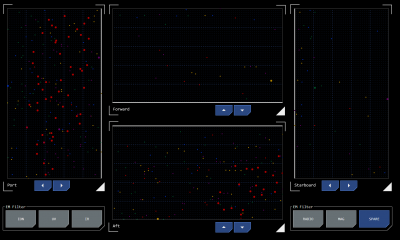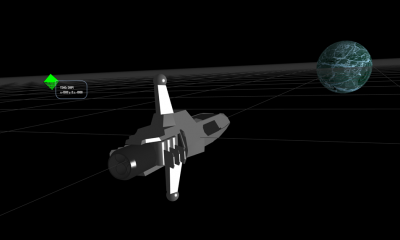
Maintaining awareness of what’s happening in space around the ship is one of the most critical functions performed by the tactical team. Unlike in science fiction other vessels don’t just automatically appear on “long range sensors”. They can only be detected and tracked by the radiation they emit, ideally before they have a chance to detect your own ship.
Who wins the resulting hunt will be decided by the skill of EMDAR operators, a specialist group within the tactical team who interpret clouds of electromagnetic (EM) radiation for clues to the location and intent of distant vessels. The passive sensor technology used by EMDAR means there are no scans that could be used to trace the ship’s own position, but while the system can estimate the distance to an EM source it can’t determine direction. This makes pinpointing the location of other vessels a real challenge.
 EMDAR operators look at changes in the intensity and range of EM for insights into the location and behaviour of other vessels. To assist with this, data visualisations display historical EM data that allows operators to spot trends. These are known as ‘waterfall displays’ because of the distinctive progression of data down the visualisation.
EMDAR operators look at changes in the intensity and range of EM for insights into the location and behaviour of other vessels. To assist with this, data visualisations display historical EM data that allows operators to spot trends. These are known as ‘waterfall displays’ because of the distinctive progression of data down the visualisation.
“It can surprise people how much you can tell from what looks like a random cloud of dots,” says Chief Petty Officer Alex Peterson, one of the specialists involved in developing EMDAR technology for the ISDC.
“On the other hand, you have to be careful not to jump to conclusions too early. Building an EMDAR track can be a pretty painstaking process.”
Shifts in EM range over time show up on waterfall displays as ‘drifts’. The direction of the drift indicates if the EM source is getting closer or further away, or even if EM is being generated by multiple sources. EMDAR operators work closely with the quartermaster to request changes in the ship’s own course that may produce tell-tale EM drifts.
 Once confident that what they’re seeing really is another vessel, the team will designate the EM source as a contact. The EMDAR team’s ultimate goal is to refine the possible location of a contact enough to achieve a track. Once that is done, highly targeted narrowband EMDAR arrays can lock on and track it automatically. Until then, the team is still expected to provide as much information as possible on the location and behaviour of contacts.
Once confident that what they’re seeing really is another vessel, the team will designate the EM source as a contact. The EMDAR team’s ultimate goal is to refine the possible location of a contact enough to achieve a track. Once that is done, highly targeted narrowband EMDAR arrays can lock on and track it automatically. Until then, the team is still expected to provide as much information as possible on the location and behaviour of contacts.
“It’s my job to be able to provide an accurate assessment of the TOE,” says tactical officer Lieutenant Neeraj Anahira, referring to the Tactical Operating Environment (TOE), a technical designation of the space surrounding the vessel.
“Both the Captain and I can view the contact board, but that doesn’t give any insight into maneuvering behaviour. I’m relying on the EMDAR team to provide those insights so I can pass them on as part of my advice to the Captain.”
As with most ship systems, the real complexity is not in operating the consoles but in understanding and applying the principles of the specialisation.
“And that takes experience,” says Peterson. “The system itself is very intuitive to use. Getting what you need from it requires a good understanding of tactical fundamentals.”
Becoming an EMDAR specialist
Trainee EMDAR specialists will participate in an initial navigation principles seminar, providing a framework for visualising objects in space. This will be followed by specialist seminars focussed on EMDAR assessment techniques including practical exercises. From there trainees have access to their own simulations so that they can practise wherever they are.
Once they think they have the right stuff trainees will undertake a series of evaluation exercises. If successfully completed, trainees can then take part in competitive hunt/kill simulations. These exercises will be used to begin selecting candidates for advanced training to be part of Endeavour’s launch crew.
- Log in or register to post comments







